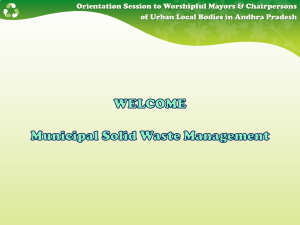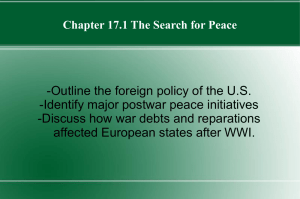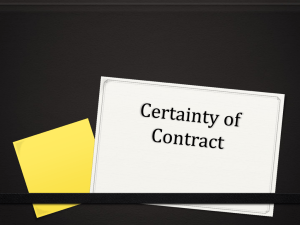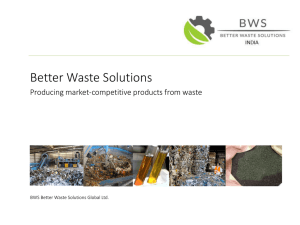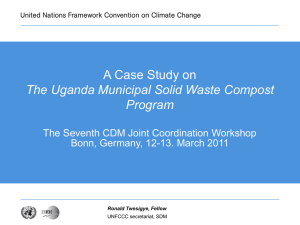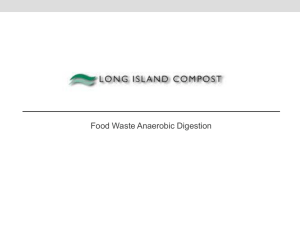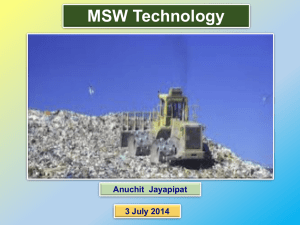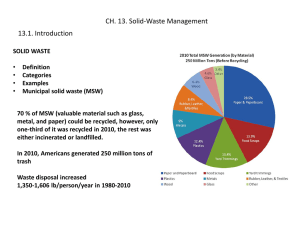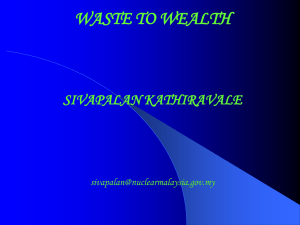Waste Recycling Cluster
advertisement
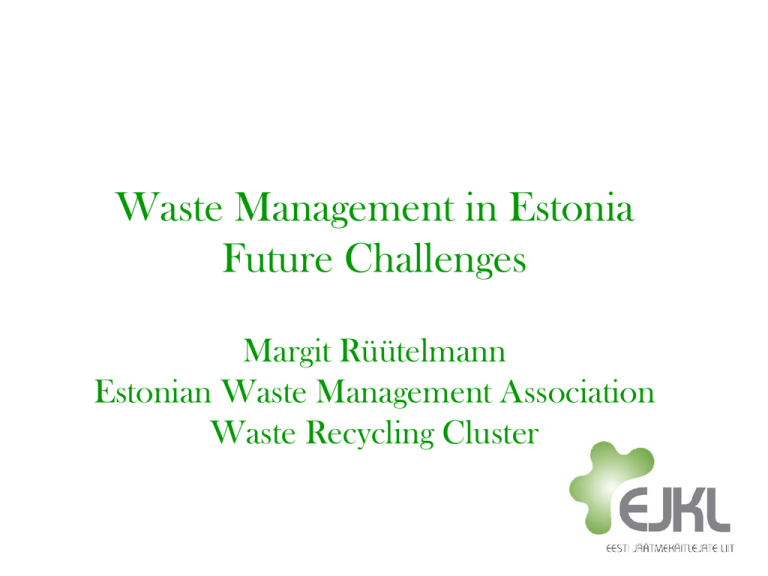
Waste Management in Estonia Future Challenges Margit Rüütelmann Estonian Waste Management Association Waste Recycling Cluster Estonian Waste Management Association Established in 1996 by 26 waste management companies. In 2006 over 50 members Today 40 members, 13 individual members The mission of EWMA is to stand for the common interests of the members and to develop waste management in Estonia directed by the general principles of sustainable development. Waste generation The dominating waste sources are: oil shale mining oil shale chemistry power production Municipal waste forms about 3-4 % of the total amount of waste. Waste generation Generated waste in million tons: Year Total Hazardous Recycled % 2006 20,0 6,7 7,5 37,3% 2007 21,3 8,6 6,7 31,7% 2008 19,3 7,7 5,8 30,2 % 2009 15,6 6,8 4,4 28,3% Generation of MSW Year Total Recycled Landfilled Recycling % 2006 593 267 179 703 373 270 30,3% 2007 644 881 120 466 390 122 18,7% 2008 502 540 113 393 333 130 22,6% 2009 441 326 97 861 287 062 22,2% 2010 246 851 -13,5% Waste generation, 2010 Waste taken to the landfill sites incl. MSW Landfilled 353 518 tons 268 938 tons 286 475 tons incl. MSW Recycled by landfill operators 246 851 tons 67 043 tons Composition of MSW MSW in EU 25 Waste generation Number of inhabitants: 1,34 million (01.01.2010) Total amount of waste generated – 15,6 million tons 11,6 tons/person Generation of municipal waste – 441 326 tons 329 kg/person Landfills National Waste Management Plan 2002-2007 7-9 landfill sites in Estonia The closure process of non-compliant landfill sites started in 2001 In 1999 Estonia had 351 municipal landfills July 16th, 2009 6 compliant landfill sites (5 for municipal waste +1 for hazardous waste) Landfills in 1999 Landfills in 2011 Pollution Charge Pollution charge for release of waste into the environment 2008 2011 2012 2013 2014 2015 8,5 EUR per ton of waste 14,38 EUR 17,25 EUR 20,77 EUR 24,86 EUR 29,84 EUR Gate fee in landfill sites for MSW is about 50 EUR/t. Pollution Charge 3/4 of the pollution charge goes to the local authority for the development of waste management in the area. Restriction If local authority has not fulfilled the obligation to administer organized municipal waste collection – no pollution charge. Organized Municipal Waste Collection Obligation since January 1st, 2005. Organized municipal waste collection covers municipal waste from households and enterprises. The aim of organised municipal waste collection is to get almost all municipal waste holders covered with contracts. Organized Municipal Waste Collection About 220 local authorities. Low-density areas. Co-operation between small local authorities. Report of National Audit Office - 43% of local authorities do not have organised municipal waste collection. Organized Municipal Waste Collection Until Dec.31st, 2010 – competition to grant special or exclusive right to collect waste within certain transport area. Since Jan.1st 2011 – competitions according to the rules provided by Public Procurement Act – services concession. In-house agreements are prohibited. Future Perspectives National Waste Management Plan 2008 - 2013 General trends defined: Separate collection of waste MBT Recovered fuels Mass incineration Treatment capacities, MSW Company 2010 2011 - 2013 Tallinn Landfill Ltd RDF 40 000 tons MSW 100 000 tons MSW March 2011 Ragn-Sells RDF - 120 000 tons MSW Autumn 2011 Estonian Energy, Iru Heat and Power Plant Mass incineration - 220 000 tons MSW June 2013 TOTAL: 440 000 tons Treatment capacities, MSW Re-use and recycling + RDF, mass incineration 440 000 tons/year + Capacity of 5-6 landfills (in 2010 - 286 000 tons of waste was landfilled ) Generation of MSW 450 – 500 000 tons/year Overcapacity – competition between treatment facilities. RDF incineration Kunda Nordic Cement 2010 23 000 tons of recovered fuels incinerated incl 12 000 tons of RDF incl 6 000 tons of RDF produced in Estonia 2011 29 000 tons of recovered fuels RDF produced in Estonia was also exported to Latvia – Cemex. Waste Recycling Cluster What is a cluster? The objectives of the cluster – To increase the added value of the companies – To increase the sales of the products-services and export. Driving force – Co-operation between the companies of the same and different sectors and research & educational institutions. Project partners 17 companies 15 waste management companies road building company cement company 3 research and educational institutions Estonian University of Life Sciences Tallinna Technical University Tartu University Türi Colledge Cluster is open to new partners. Cluster development 1. Dec, 2009 – Nov, 2010 Preliminary projects – Compost production and production of recycled aggregates from C&D waste. 2. Jan.01, 2011 – Dec.31, 2013 Waste Recycling Cluster Co-financed by Enterprise Estonia from the European Regional Development Fund. Main objectives of Waste Recycling Cluster 1. To increase the amounts of waste recycled in Estonia. 2. Products compliant to quality standards and sertified: – Compost – Recycled aggregates – Recovered fuels 3. To increase production capacity and volumes, joint marketing. 4. To increase sales of the products-services and export. Waste -> Products Waste Recycling Cluster Production of recovered fuels Production of recycled aggregates Production of compost Activities • Study-trips -> acquire the knowledge and experiences other countries, partners search. • Research - > market research, quality of the products, capacity sharing. • Seminars, conferences. • Development of training programs for the employees. • Participation in other projects. Production of compost Production of compost Production of compost Production of recycled aggregates Production of recycled aggregates Production of RDF RDF in Kunda Nordic Cement Contacts Margit Rüütelmann margit@ejkl.ee www.ejkl.ee Thank you for your attention!
